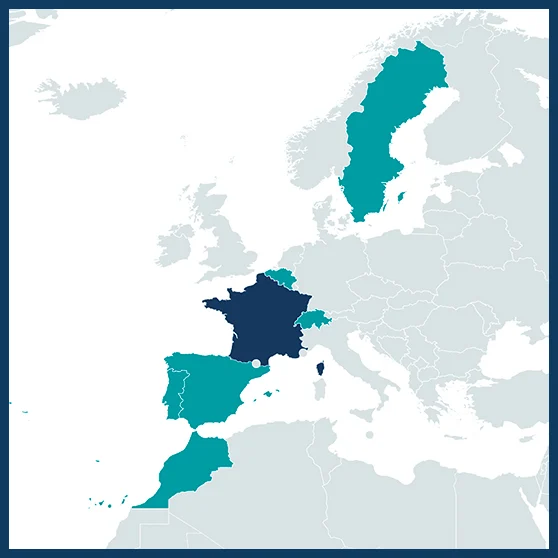01.03.2022
€ 1,304,071
François SARRAZIN
francois.sarrazin@mnhn.fr
Coordinator: Ecology and Conservation Sciences (CESCO), CNRS/MNHN/Sorbonne University, Paris, France
Biodiversity and Landscape, Liège University, Gembloux, Belgium
Biotope, Mèze, France
Databases on Biodiversity, Ecology, Environment and Societies (BBEES), CNRS/MNHN, Paris, France
Ecology, Systematics and Evolution (ESE), Paris- Saclay University/CNRS/AgroParisTech, Saint- Aubin, France
Environmental Engineering and Agrobiotechnology, Sultan Moulay Sliman University, Khénifra, Morocco
Plant Biology, Association for the Research and Development of Sciences, Lisboa, Portugal
Biodiversity and Conservation, University King Juan Carlos, Mostoles, Spain
Ecology, Swedish University of Agricultural Sciences, Uppsala, Sweden
Botanical Garden, University of Bern, Bern, Switzerland

Numerous stakeholders with different values and expectations conduct reintroductions, reinforcements, or assisted colonisations of wild populations in a wide range of ecosystems. While biodiversity conservation and restoration are generally implemented within a human time frame, they might constitute major transitions at the scale of evolution. Current research on conservation translocations aims to improve translocation success to ensure that they contribute to species or ecosystem recovery in the long term and that their potential impacts on social ecosystems are managed to avoid retroactively undermining their performance. However, few studies have considered a strategic approach in the assessment and optimisation of the allocation of translocation efforts at larger scales. Indeed, in the context of global changes including climate change, land use intensification and biological invasions, the extent to which an accumulation of locally implemented translocations can contribute to biodiversity conservation on regional, continental or global scales remains unclear. Since conservation translocations raise debates regarding their economic and human costs, as well as ethical and environmental issues, it is important to provide evidence-based arguments to describe where, when and how they can contribute to biodiversity conservation and ecological restoration/rewilding in their evolutionary, functional and social dimensions at larger spatial, temporal and organisational scales. This is the main purpose of Transloc.
The main objective of Transloc is to investigate and quantify how local conservation translocations affect ecological, evolutionary and sociological trajectories of restoration at multiple scales in the Western Palearctic. It will mix different approaches from database implementation and analyses to modelling, field monitoring and experiments. Over the past years, three Parisian laboratories now involved in the Transloc project gathered information on more than 1,300 conservation translocations in the Western Palearctic, involving a wide range of taxa (e.g. mammals, birds, plants, lichens), in terrestrial and aquatic habitats. The Transloc project will largely rely on pursuing the development of this database, collecting complementary data on a wider range of taxa (e.g. reptiles, amphibians, molluscs, insects…), and disseminating data to practitioners, stakeholders and researchers to increase common knowledge on conservation translocations and advise policies. Additionally, a batch of ongoing well-monitored field translocations and experimental translocations will be analysed from ecological, economical, and social points of view. All these data will be confronted to the development of shared success and performance criteria. For some case studies, modelling and serious games will be considered to build up translocation scenarios with local stakeholders. Beyond these local situations, networking with translocation practitioners, stakeholders including farmers, foresters, local representatives, and policy makers will be at the core of the project.
Transloc project will be structured to produce a wide range of outcomes. Firstly, it will particularly aim to document, quantify and analyse translocation efforts and assess their contribution to biodiversity patterns. In that aim, the costs of these programmes and the constraints and opportunities linked to policies at various scales will be considered. Secondly, the efficacy of translocations will be defined and evaluated based on both the viability of translocated populations, and their effects on species recovery at multiple scales. This will allow assessing translocation cost- effectiveness. Thirdly, the relevance of translocations will be analysed through the congruence of translocation efforts with global changes particularly climate change. Fourthly, the social and economic effects of translocations will be estimated through the study of stakeholder engagement and governance, co-benefits and conservation conflicts as well as the ethical dimensions of translocations. Finally, a global and multi-facetted synthesis of these complementary approaches will be produced to assess the performance of translocations. The potential impact of these researches will allow enhancing the understanding and implementation of translocations in the Western Palearctic but also worldwide and actively contribute to biodiversity restoration at local and global scales.
Involving both local stakeholders and policy makers in Transloc will produce key recommendations, guidelines and policy briefs on translocation strategies and practices, systematic conservation planning and other environmental approaches embracing short and long-time scales and regional, national and European policies. Interactions with European authorities will improve the relevance of translocations for EU’s biodiversity goals and those of European policies and funding for the contribution of translocations to these goals. At a global scale, the potential renewal of the IUCN guidelines on conservation translocations and new guidelines on rewilding will benefit from Transloc outcomes on the eco-evolutionary, social and economic contributions of translocations to biodiversity restoration.
Beyond the extensive documentation of all conservation translocations in the Western Palearctic compiled through the Transloc database, experiments and case studies will be assessed including e.g. Freshwater mussels in Belgium and France, numerous plant species in Belgium, France, Spain and Switzerland (e.g., Marsilea quadrifolia and other species from wetlands, Arenaria grandiflora, Centaurea corymbosa…), the guild of Vultures in Southern France and Europe, Lynx in Portugal, and Eurasian beavers in many European countries. Companion modelling will be used to explore scenarios of translocation of large mammals (e.g., European Bison) and other species with significant socio-economic impacts on local communities.
- Agence Nationale de la Recherche (ANR), France
- The Research Foundation – Flanders (FWO), Belgium
- Ministry of National Education, Vocational Training, Higher Education and Scientific Research (MENFPESRS), Morocco
- Fundação para a Ciência e a Tecnologia (FCT), Portugal
- State Research Agency (AEI), Spain
- Swedish Environmental Protection Agency (SEPA), Sweden
- Swiss National Science Foundation (SNSF), Switzerland